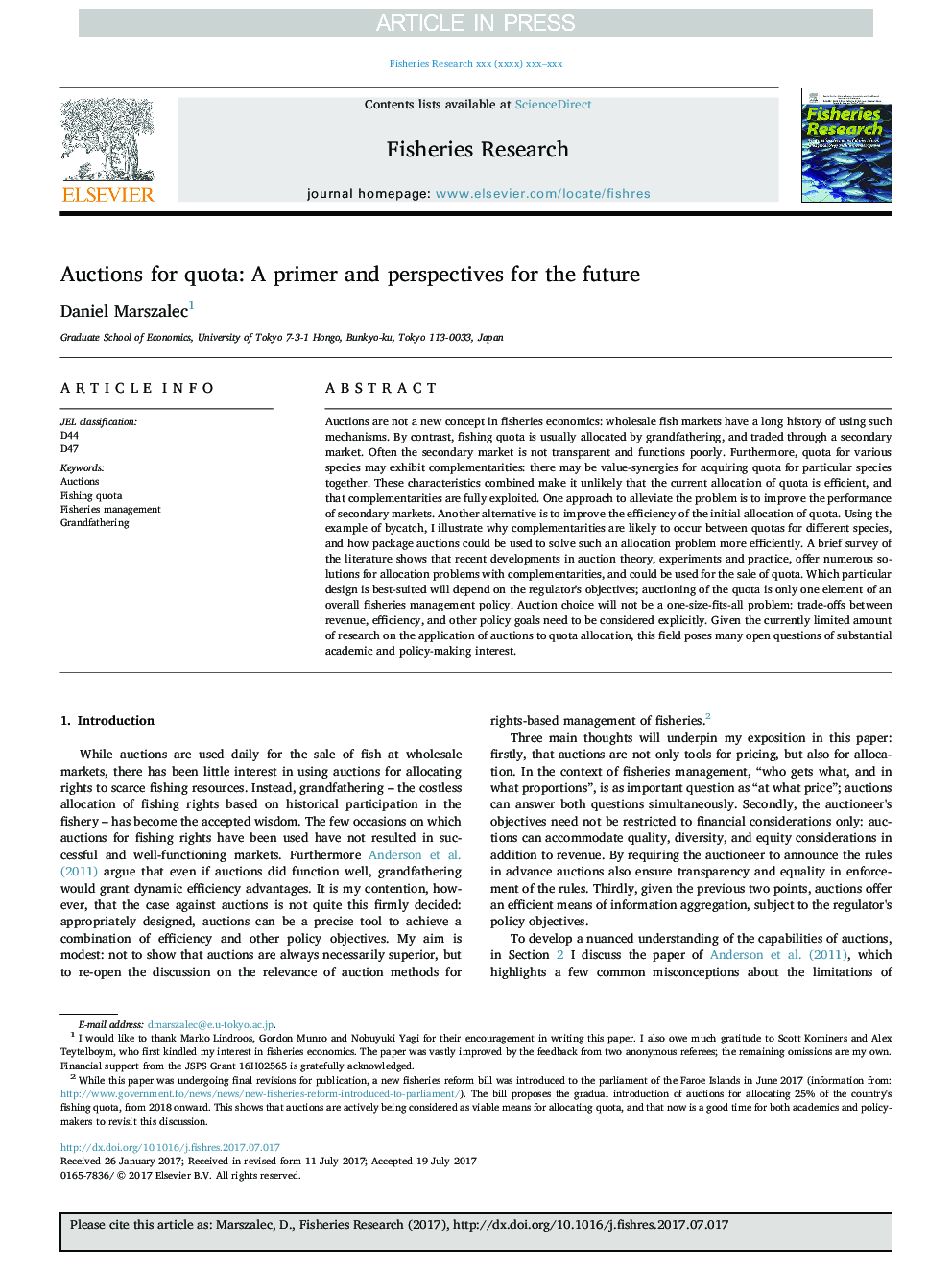| کد مقاله | کد نشریه | سال انتشار | مقاله انگلیسی | نسخه تمام متن |
|---|---|---|---|---|
| 8885456 | 1626767 | 2018 | 9 صفحه PDF | دانلود رایگان |
عنوان انگلیسی مقاله ISI
Auctions for quota: A primer and perspectives for the future
ترجمه فارسی عنوان
مزایده برای سهمیه بندی: آغازگر و چشم انداز
دانلود مقاله + سفارش ترجمه
دانلود مقاله ISI انگلیسی
رایگان برای ایرانیان
ترجمه چکیده
مزایده ها در اقتصاد شیلات یک مفهوم جدید نیستند: بازار ماهی های عمده فروشی دارای سابقه طولانی در استفاده از چنین مکانیزمی است. در مقابل، سهمیه ماهیانه معمولا به وسیله پدربزرگ و مادربزرگ اختصاص داده می شود و از طریق بازار ثانویه معامله می شود. اغلب بازار ثانویه شفاف و عملکرد ضعیف نیست. علاوه بر این، سهمیه برای گونه های مختلف ممکن است مکمل ها را نشان دهد: ممکن است همگامی ارزش برای به دست آوردن سهمیه برای گونه های خاص با هم وجود داشته باشد. این خصوصیات ترکیب شده، بعید است که تخصیص فعلی سهمیه موثر باشد و این که مکمل یکدیگر کاملا بهره برداری می شوند. یک رویکرد برای رفع مشکل، بهبود عملکرد بازار ثانویه است. جایگزین دیگری برای بهبود کارایی تخصیص اولیه سهمیه است. با استفاده از نمونه های جانبی، من نشان می دهم که چرا ممکن است مکمل بودن بین سهمیه بندی برای گونه های مختلف رخ دهد و چگونه می توان از مزایده بسته برای حل چنین مشکل تخصیص بیشتر استفاده کرد. بررسی مختصر ادبیات نشان می دهد که پیشرفت های اخیر در تئوری حراست، آزمایش ها و عمل، راه حل های متعددی برای مشکلات تخصیص با مکمل ها ارائه می دهد و می تواند برای فروش سهمیه استفاده شود. کدام یک از طراحی های مناسب مناسب تر است به اهداف تنظیم کننده بستگی دارد؛ حراج سهمیه تنها یک عنصر از یک سیاست کلی مدیریت ماهیگیری است. انتخاب مزایده یک مشکل بزرگ برای همه نخواهد بود: باید به صراحت در نظر گرفته شود. با توجه به حجم محدود تحقیقات در مورد استفاده از مزایده ها برای تخصیص سهمیه بندی، این زمینه بسیاری از پرسش های باز از علاقه های علمی و سیاست گذاری قابل توجهی را نشان می دهد.
موضوعات مرتبط
علوم زیستی و بیوفناوری
علوم کشاورزی و بیولوژیک
علوم آبزیان
چکیده انگلیسی
Auctions are not a new concept in fisheries economics: wholesale fish markets have a long history of using such mechanisms. By contrast, fishing quota is usually allocated by grandfathering, and traded through a secondary market. Often the secondary market is not transparent and functions poorly. Furthermore, quota for various species may exhibit complementarities: there may be value-synergies for acquiring quota for particular species together. These characteristics combined make it unlikely that the current allocation of quota is efficient, and that complementarities are fully exploited. One approach to alleviate the problem is to improve the performance of secondary markets. Another alternative is to improve the efficiency of the initial allocation of quota. Using the example of bycatch, I illustrate why complementarities are likely to occur between quotas for different species, and how package auctions could be used to solve such an allocation problem more efficiently. A brief survey of the literature shows that recent developments in auction theory, experiments and practice, offer numerous solutions for allocation problems with complementarities, and could be used for the sale of quota. Which particular design is best-suited will depend on the regulator's objectives; auctioning of the quota is only one element of an overall fisheries management policy. Auction choice will not be a one-size-fits-all problem: trade-offs between revenue, efficiency, and other policy goals need to be considered explicitly. Given the currently limited amount of research on the application of auctions to quota allocation, this field poses many open questions of substantial academic and policy-making interest.
ناشر
Database: Elsevier - ScienceDirect (ساینس دایرکت)
Journal: Fisheries Research - Volume 203, July 2018, Pages 84-92
Journal: Fisheries Research - Volume 203, July 2018, Pages 84-92
نویسندگان
Daniel Marszalec,
